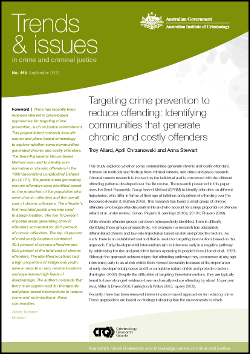
There has recently been renewed interest in place-based approaches for targeting crime prevention, such as justice reinvestment. This project linked research from life course and place-based criminology to explore whether some communities generated chronic and costly offenders.The Semi-Parametric Group-based Method was used to identify non-normative or chronic offenders in the 1990 Queensland Longitudinal Dataset (n=14,171). The postal areas generating chronic offenders were identified based on the proportion of the population who were chronic offenders and the overall cost of chronic offenders. The offender’s first recorded postal area was used to assign location. The top 10 percent of postal areas generating chronic offenders accounted for 20.5 percent of chronic offenders. The top 10 percent of most costly locations contained 40.4 percent of chronic offenders and 50.5 percent of the total cost of chronic offenders. The identified locations had a high proportion of Indigenous youth, were in remote or very remote locations and experienced high levels of disadvantage. The authors conclude that there is an urgent need for therapeutic and place-based interventions to reduce crime and victimisation in these communities.
